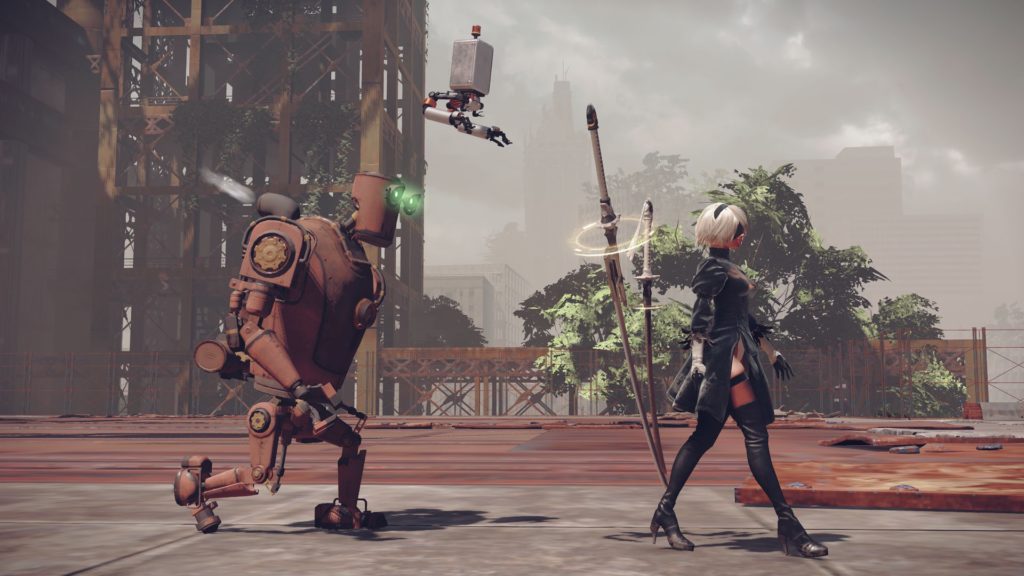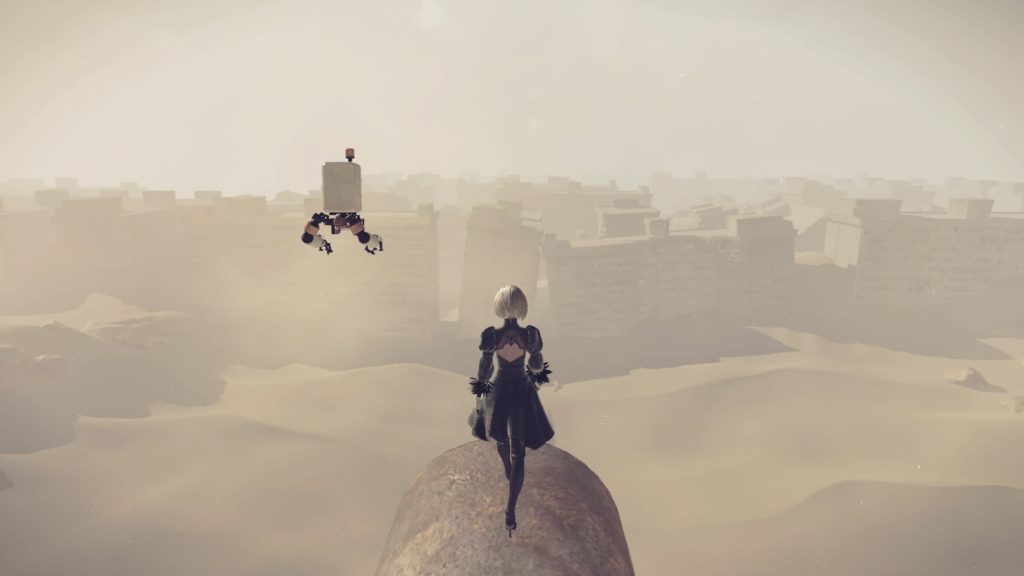Image Credits: Berduu
Beneath the overgrowth lies the ruins of a metropolis. The fallen city is a waypoint in the world of Nier: Automata – a field of toppling towers that ties together the shifting desert sands, forgotten forests and decaying industrial parks. But for the shearing of metal and creaking of clockwork machinery, it is a world that has fallen silent. This is a time after humans, where the androids they constructed to stave off extinction have inherited the world they left behind. And in their absence, an endless war rages. A quick glance backward in the series’ history takes you to the original Nier, and to Drakengard. The opening of a portal in the sky unleashed a horror from another world, and the human race perished in its wake. In the androids they created to protect them, the embers of humankind still flutter. But in the race of alien machines that oppose them does human culture, belief and behaviour serve as a blueprint for evolution, and eradication.
The world of Nier: Automata is unveiled with a steady hand, as little by little, the remnants of a civilisation ground into rubble are cast in the light of two intersecting ages of conflict. It’s in individual pieces that the story of Nier is constructed, an episodic form tying together every thread of the narrative with a fade to black and rolling of the credits. To unfold the fate of its android protagonists, the sight of game director Yoko Taro’s name adorning the screen will become all too familiar. And to wander the world in search of answers to the abstract and the obtuse is to find meaning in the otherwise misinterpreted. As the automatons of Nier evolve and change with a deeper understanding of humans, so does the player at the helm find clarity in the vestiges that remain.
Nier doesn’t put players at the mercy of its narrative. And it doesn’t need to be examined through the lens of a microscope. Its world is one of flux, where intimate and personal stories of hardship and fear are told through mechanical mouths. It is both a recollection of what came before as much as it is a contemplation of what is yet to come. However deep you choose to delve, Nier offers something to think upon. Nier’s foremost conclusion depicts the struggle of Earth’s android defenders and the depths of their emotional fragility. As ten hours with the game become fifty, the story of three androids burdened with humanity’s preservation becomes an elaboration as much as it is a conclusion. But however you choose to experience the story of Nier, its thematic style – even in absurdity – retains an unshakeable consistency.
In pursuit of Nier’s final end, you’re given ample time to wander a broken Earth and pore over the collective psyche of its inhabitants. Many machines cry “Death to the androids!” as they lunge clumsily in your direction. Others though care not for the war in which they are ordered to fight, or the network that holds them in servitude. Across both its main narrative and the collection of smaller stories that make up its side-quests, Nier: Automata is a game about what it means to be human and the purpose with which we all live our lives. Amidst this struggle are stories of love, abandonment, hate, regret, loyalty and lust. As Nier depicts a time perpetual strife, it calls into question the very worth of life. Though as the darkness edges ever closer, so does the light break free. Nier is a push and pull between peace and war, comfort and anxiety, all draped in a garb of existentialism. It isn’t told with a voice so ridden by hatred that is comes across as nothing more than a lament – Nier is a duality, a balanced tale of a world as recognisable as it is alien, and one in which the questions it deliberates are comprised of very human emotion.
* * *
Seared into the circuitry of the machines is an imprint of humanity. In one side-quest, four machines stand on the edge of an overlook, hundreds of feet in the air. They stand in silence, completely unperturbed by the presence of androids. And they won’t talk to you. In fact, the only way in which to provoke a reaction is to initiate the hacking mini-game and overtake their core. In doing so, their inner thoughts pour forth: they curse a life in which they have no control and how their choices seem to have no real consequence. “Was it seriously trying to figure out the meaning of its existence?” exclaims android 9S. The four robots choose death, leaping from their ledges and disappearing into the ground as control seamlessly returns to the player. In another, a reclusive operator of the YoRHa command is overjoyed to have received a picture of a flower as taken by android 2B. In her elation, she remarks that she would like to venture down to Earth, though her duties remain on the space station. The operator, like the android soldiers she directs, and like the contemplative machines who took their own lives, is trapped. Two unique interactions offer two disparate messages – the former lies in dread, the other in kindness. There, in between contrasting and often unfulfilling conclusions does Nier finds comfort in its own melancholy.
Towards the end of the game, the author escapes the page and asks questions of the player. In particular, you are asked to offer up your entire save game data in order to make the subsequent battle easier for future players. Before this, players from the UK, USA, Macedonia and Japan had given their data so that I could reach Nier’s final, definitive end intact. I committed my fifty-hour file to the ether and was met with a simple “Thank you” in response.
In their struggles to make sense of a world in which they hold no power, 2B, 9S & A2 sacrifice everything they have in order to fulfil their purpose. Androids are tools of war designed to retake Earth from machines caught in an uncontrollable evolutionary cycle. As the androids create bigger, stronger weapons, so do the machines respond in kind. Asking that I, the player, hand over my save data was unexpected, but it was also in keeping with everything that had been built before me. One day, my save file ‘Ash_EXE’ is going to be one of several that assist another player as they then also get a chance to do likewise. In sacrificing my data to an unknown player halfway across the world, I do what I can to ensure their future success. Nier ends with a flock of android pods reassembling the trio of androids and giving them another chance to reshape the future.
“Then… won’t that lead us to the same conclusion as before?” asks one pod to another. “I cannot deny that possibility. However, the possibility of a different future also exists.” You can still break the cycle. You can still become more. As the washed-out greys of the city ruins bleed into view, Nier: Automata’s final message asks if your purpose within its cycle was ultimately worth it.
“A future is not given to you. It is something you must take for yourself.”

